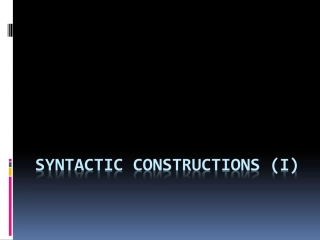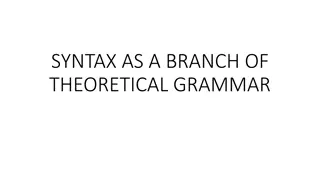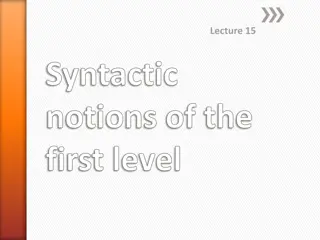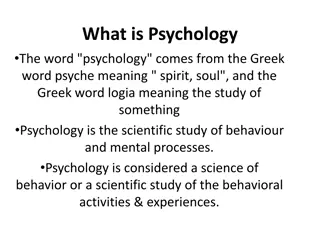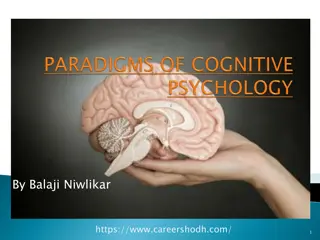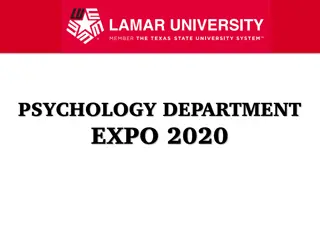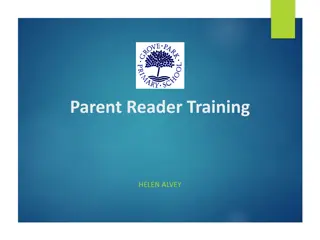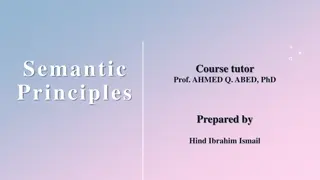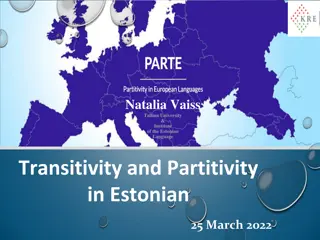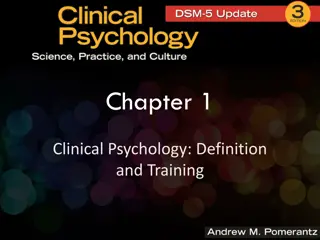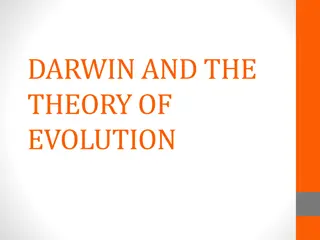Evolution of Syntactic Theory: From Psychology to Cognition
Syntactic theory has evolved significantly, influenced by psychology and cognition. The debate between phrase structure and dependency structure continues, with a shift towards integrating cognitive principles. Cognitive linguistics, including Cognitive Grammar and Construction Grammar, play a key role in this evolution. The discussion delves into the historical roots, challenges, and the ongoing development of Word Grammar since 1984.
Download Presentation

Please find below an Image/Link to download the presentation.
The content on the website is provided AS IS for your information and personal use only. It may not be sold, licensed, or shared on other websites without obtaining consent from the author.If you encounter any issues during the download, it is possible that the publisher has removed the file from their server.
You are allowed to download the files provided on this website for personal or commercial use, subject to the condition that they are used lawfully. All files are the property of their respective owners.
The content on the website is provided AS IS for your information and personal use only. It may not be sold, licensed, or shared on other websites without obtaining consent from the author.
E N D
Presentation Transcript
Syntax and cognition Dick Hudson Freie Universit t Berlin, October 2015 1
Plan 1. How syntactic theory has been influenced by psychology 2. Why cognition? 3. Phrase structure and dependency structure 4. How to choose between PS and DS? 5. A challenge for DS, and a cognitive solution 6. Towards a new kind of DS 7. New-DS and PS: are they notational variants? 8. Conclusions 2
Gesammtvorstellung 1 The roots of phrase structure a sincerely thinking person scorns deception a person thinks sincerely deception is scorned thought is sincere Who offered this analysis? Ein redlich denkender Mensch verschm ht die T uschung A sincerely thinking person scorns deception Wundt, Leipzig, 1900 3
So what? Bloomfield took this analysis from Wundt who thought top-down analysis was psychologically real but was looking at the meaning, not the words and turned it into his immediate-constituent analysis which Chomsky turned into his phrase-structure grammar using ideas from mathematics which used brackets which he turned into trees without crossing branches. So phrase structure is already based on assumptions about cognition. 4
2 Can we get away from cognition? We can certainly try. E.g. Integrational linguistics But why would we want to try? After all, language is surely a kind of knowledge. So sooner or later our theories must meet theories about knowledge. Jackendoff s graceful integration of language with the rest of cognition So we should at least try to build elementary ideas about other areas of cognition into our theories of language. 5
Cognitive linguistics This is one of the goals of cognitive linguistics Including Cognitive Grammar (Langacker) Construction Grammar (Goldberg, Croft) Word Grammar My talk is about Word Grammar developing since 1984 still changing so some of this talk is new 6
3 Phrase structure or dependency structure? Two traditions in syntax: Phrase structure Born in the USA (but inspired by Germany) 1933 Bloomfield 1957 Chomsky etc Dependency structure Much older Born in the Middle East and Europe But taught in the USA in the 19th century (Reed and Kellogg diagrams) 1959 Tesni re 7
Phrase structure The only relation recognised is the part-whole relation Small babies cry. cry. small babies small babies 8
Dependency structure The only relation recognised is the dependency between two words. WG stemma subject adjunct babies cry. babies cry. small small 9
How a DS grammar works Every word has a valency the dependents that it needs (WG only) also its need for a parent (a word on which it depends) These needs must be satisfied by other words Totally bottom-up . Every word also has a meaning lexical meaning modified by dependents babies means small babies when modified by small cry means small babies cry when modified by babies modified by small 10
4 How to choose between PS and DS? Consider the facts e.g. maybe c-command is important and requires PS? Look for elegance count the nodes Look at general cognition what kinds of relations can we recognise in general? answer: many different kinds!!! part-whole relations social relations among individuals spatial relations among objects relations between events and their participants etc etc etc 11
So the winner is ... Neither PS nor DS because they both recognise only one kind of relation and we know that our minds can recognise many different kinds. But DS is better than PS because the evidence for word-word relations is stronger than for phrases: lexical selection, e.g. DEPEND + ON idioms, e.g. TAKE + CARE government, e.g. MIT + Dative But there is a little evidence for phrase-like units ... 12
5 A challenge for DS a big French house = a house which is big and French But: a typical French house = a house which is typical of French houses. Noticed by Oesten Dahl 1980 typical French house WWhere is French house ? French house typical French house typical French house 13
Solution: use what general cognition offers Knowledge is a network of atomic nodes. The network distinguishes different kinds of relation including a vast and open collection of relational concepts , created as needed The isa relation allows default inheritance. We create temporary nodes for experiences. e.g. someone I saw on the street, personX 14
A tiny cognitive network city isa capital city new node citizen of capital of Germany Berliner Berlin university FU citizen of personX 15
Default inheritance This is part of node-creation. If A isa B, then the properties of A always override those of B. So we can make generalisations even when there are exceptions. 16
Default inheritance in birds 1 beak # part eggs babies bird leg part # move -ment # flying 2 1 # part wing penguin move -ment # flying 0 17
Node-creation a Y r We create a new node ( X ) for ongoing experience so that we can enrich it by classifying it as a Y, and inheriting from Y we can distinguish the experience from Y we can accommodate irregularities. And we continue to enrich it in the light of new information (Z) by creating a further node ( X|Z , X with Z ) with isa links to X. These nodes allow us to remember earlier states and they re the material of detailed constructions . For example ... b X r X|Z NB | with , not + and . Statistics: p(x|y) means the probability of x in the context of y 18
concept What is it? tin paint brush paint tin | for contains contains ? paint 19
6 Towards a new kind of DS Assume one initial node per word. This inherits directly from some lexeme in the grammar. e.g. in paint tin, we create one concept for each word token: paint tin But add an extra node for each dependent. This shows how the word s meaning is affected by each dependent. e.g. we create an extra concept for tin as modified by paint : tin | paint And we link the two nodes by isa . tin 20
New-DS: paint tin PAINT TIN | PAINT TIN tin tin | paint paint dependent means means means tin for paint tin paint 21
Back to typical French houses. house | French modified by typical typical French house typical French house house|French | typical house modified by French means French house house | French means typical French house house means 22
New-DS and PS house|French | typical PS house | French house+French + typical typical French house house + French new-DS Notational variants?? typical French house 23
Isa, not part-of A (house + French) A (house | French) A isa B B is-part-of A B (house) B (house) A isa B: like Mary isa linguist shared properties same size B is-part-of A: like Mary s foot is-part-of Mary different properties different size 24
No unary branching in new-DS. PS needs both A and B because they have different properties, even when they have the same size. New-DS doesn t and can t. higher nodes are only needed where there s a dependent. sentence Hurry!/3 PS new-DS Hurry!/2 VP Hurry! (word) Hurry!/1 word 25
New-DS guarantees headedness A problem for DS? Student after student came in. (Jackendoff) What is the head? Answer: the first student,just like tin of paint. But why no determiner? Stipulated, as in to school, at home wine from France but: the wine of France A construction definable, as usual, in terms of dependencies 26
In new-DS single dependencies are constructions e.g. GIVE NP A HARD TIME subject verb direct GIVE indirect direct A|HARD TIME GIVE|time 27
New-DS allows meaning-order mismatches People are sometimes very tall. = Some people are very tall. = sometimes (people are very tall) John is typically late again. = John is late again, and John being late is typical. I needed a small brass screw, but I could only find a steel one. one = small screw , not brass screw or small brass screw ! 28
How does New-DS allow this mismatch? I needed a small brass screw, but I could only find a steel one. one = small screw . screw|brass & small ? small screw sense sense screw | small screw | brass steel one small brass screw 29
8 Conclusions Syntactic theory should build on cognitive science. We should assume that our minds can apply any general-purpose cognitive machinery to language. This affects our assumptions about syntactic structure. It throws new light on the old dispute about PS versus DS. It allows us to develop a new version of DS which is more similar to PS. But even new-DS is different from PS and better! 30
Danke fr Ihre Aufmerksamkeit und Geduld! This slide show is available at dickhudson.com/talks Word Grammar offers much, much more ... see dickhudson.com/word-grammar/ 31


